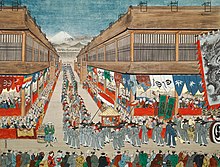Joseon Tongsinsa
| ||||||||||||||||||||||||||||||||||||||||||||||||||||||||||||||||||||||||||||||||||||||||||||||||||||||
Read other articles:

American jazz keyboardist, arranger, and record producer For other people named Bob James, see Bob James (disambiguation). This biography of a living person needs additional citations for verification. Please help by adding reliable sources. Contentious material about living persons that is unsourced or poorly sourced must be removed immediately from the article and its talk page, especially if potentially libelous.Find sources: Bob James musician – news · newspapers&…

この項目には、一部のコンピュータや閲覧ソフトで表示できない文字が含まれています(詳細)。 数字の大字(だいじ)は、漢数字の一種。通常用いる単純な字形の漢数字(小字)の代わりに同じ音の別の漢字を用いるものである。 概要 壱万円日本銀行券(「壱」が大字) 弐千円日本銀行券(「弐」が大字) 漢数字には「一」「二」「三」と続く小字と、「壱」「弐」…

本條目存在以下問題,請協助改善本條目或在討論頁針對議題發表看法。 此條目需要擴充。 (2013年1月1日)请協助改善这篇條目,更進一步的信息可能會在討論頁或扩充请求中找到。请在擴充條目後將此模板移除。 此條目需要补充更多来源。 (2013年1月1日)请协助補充多方面可靠来源以改善这篇条目,无法查证的内容可能會因為异议提出而被移除。致使用者:请搜索一下条目的标…

SMK Negeri 4 TasikmalayaSekolah Menengah Kejuruan Negeri 4 TasikmalayaInformasiDidirikan2012JenisNegeriAkreditasiANomor Statistik Sekolah401327810004Nomor Pokok Sekolah Nasional20276063Kepala SekolahKurniawan, S.Pd, M.Pd.Ketua KomiteAbun Sulaeman, S.Ag.KurikulumKurikulum MerdekaStatusSekolah NegeriAlamatLokasiJl. Depok RT 02 RW 05, Sukamenak, Purbaratu, Tasikmalaya, Jawa Barat, IndonesiaTel./Faks.+62265312059Koordinat7°19′49″S 108°15′15″E / 7.3302379°S 108.25…

2001 studio album by Rosario FloresMuchas FloresStudio album by Rosario FloresReleasedOctober 2001GenreLatin popLength37:44LabelBMG InternationalProducerFernando Illán, Cachorro LópezRosario Flores chronology Jugar a la Locura(1999) Muchas Flores(2001) De Mil Colores(2003) Muchas Flores (Many Flowers)[1] is the sixth studio album released by Spanish performer Rosario Flores. It was released by BMG International in 2001. The album was produced by Fernando Illán and Cachorro Ló…

Lower house of the Alabama legislature This article needs additional citations for verification. Please help improve this article by adding citations to reliable sources. Unsourced material may be challenged and removed.Find sources: Alabama House of Representatives – news · newspapers · books · scholar · JSTOR (January 2019) (Learn how and when to remove this message) Alabama House of RepresentativesTypeTypeLower house of the Alabama Legislature Term lim…

This article relies excessively on references to primary sources. Please improve this article by adding secondary or tertiary sources. Find sources: Trifecta Entertainment & Media – news · newspapers · books · scholar · JSTOR (February 2010) (Learn how and when to remove this message) Trifecta Entertainment & MediaIndustryTelevision syndicationFounded2006; 18 years ago (2006)Websitetrifectaentertainment.com Trifecta Entertainment…

English artist (1902–1998) This article is about the 20th century artist. For the 17th century traveler, see Celia Fiennes. Celia FiennesFiennes in 1928BornCelia Mary Twisleton-Wykeham-Fiennes(1902-03-10)10 March 1902Ealing, MiddlesexDied17 September 1998(1998-09-17) (aged 96)Culworth, EnglandEducationCentral School of Arts and CraftsKnown forPrintmaking, PaintingSpouse(s)Noel Rooke, m.1932-1953, his death Celia Mary Twisleton-Wykeham-Fiennes known as Celia Fiennes and later Celia Ro…

Myths of China Nine Dragons, handscroll section, by Chen Rong, AD 1244, Song dynasty, Museum of Fine Arts, Boston Part of a series onChinese folk religion Concepts Tian—Shangdi Qi Shen Ling Xian ling Yinyang Hundun Mingyun Yuanfen Baoying Wu Theory Chinese theology Chinese gods and immortals Chinese mythology Chinese creation myth Chinese spiritual world concepts Model humanity: Xian Zhenren Wen and wu Practices Fenxiang Jingxiang Feng shui Miaohui Wu shamanism Jitong mediumship Precious scrol…

Lesbian bar in New York City (1925–1926) Eve's HangoutEve Adams' TearoomThe former site of Eve's Hangout, now a restaurant, and wine tasting room.Address129 MacDougal StreetManhattan, New York CityCoordinates40°43′52″N 74°00′01″W / 40.73098°N 74.00018°W / 40.73098; -74.00018OwnerEva KotcheverTypeSpeakeasy, Lesbian bar, TearoomOpened1925Years active2 Eve's Hangout was a New York City lesbian nightclub established by Polish-Jewish feminist Eva Kotchever in Gre…

الجزء المحجري للعظم الجبهي الاسم العلميpars orbitalis ossis frontalis السطح الخارجي من العظم الجبهي. الجزء المحجري الثالث من الأسفل السطح الداخلي من العظم الجبهي. الجزء المحجري الثالث من الأسفلالسطح الداخلي من العظم الجبهي. الجزء المحجري الثالث من الأسفل تفاصيل جزء من عظم جبهي معرفا�…

XB-38 Flying Fortress adalah pesawat contoh konversi tunggal sayap rendah (low wing) dari produksi B-17E Flying Fortress, menguji apakah tipe mesin Allison V-1710 V dapat diganti untuk mesin radial standar Wright R-1820 selama awal Perang Dunia II. XB-38 adalah hasil dari sebuah proyek modifikasi yang dilakukan oleh Boeing dan Vega (anak perusahaan Lockheed) pada B-17 terbang ke Benteng agar sesuai dengan jenis mesin V liquid-cooled Allison V-1710-89. Hal itu dimaksudkan sebagai versi perbaikan …
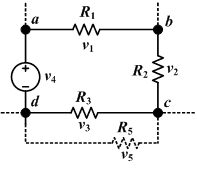
قانونا كيرشوفمعلومات عامةسُمِّي باسم غوستاف روبرت كيرشهوف لديه جزء أو أجزاء Kirchhoff's current law (en) Kirchhoff's voltage law (en) تعديل - تعديل مصدري - تعديل ويكي بيانات قانونا كيرشوف (بالإنجليزية: Kirchhoff's circuit laws) هما قانونان مهمان وضعهما العالم جوستاف كيرشوف سنة 1845[1] لتحليل الدوائر الكهربائي…
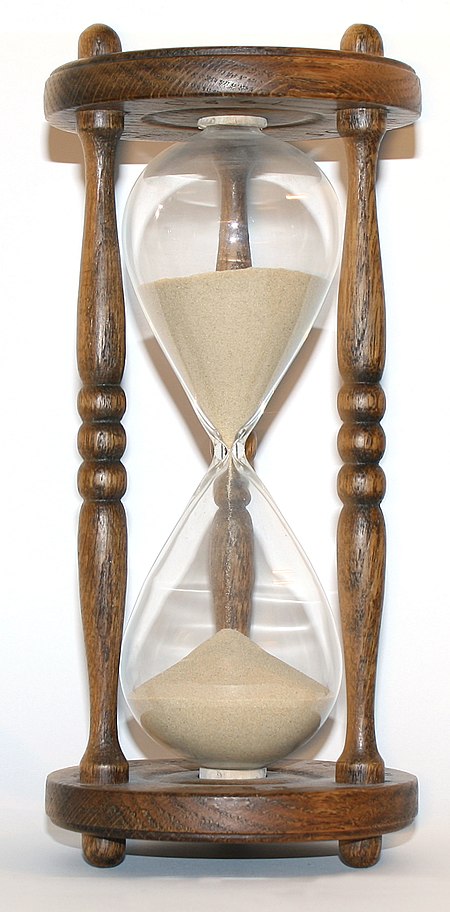
Questa voce o sezione sull'argomento astronomia non cita le fonti necessarie o quelle presenti sono insufficienti. Puoi migliorare questa voce aggiungendo citazioni da fonti attendibili secondo le linee guida sull'uso delle fonti. Segui i suggerimenti del progetto di riferimento. Nei calendari solari un anno ordinario o anno comune è un anno di 365 giorni, cioè un anno che non è bisestile. Nei calendari lunisolari, invece, un anno lunare ordinario è un anno composto da dodici lunazioni …

كأس العالم 2018 المجموعة الرابعةمعلومات عامةالرياضة كرة القدم الاتحاد الاتحاد الدولي لكرة القدم الفئة كرة القدم للرجال جزء من كأس العالم 2018 الفترة يونيو 2018 البداية 16 يونيو 2018 النهاية 26 يونيو 2018 البلد روسيا عدد الجولات 6 الفرق المشاركة القائمة ... الأرجنتين في كأس العالم 2018ن…
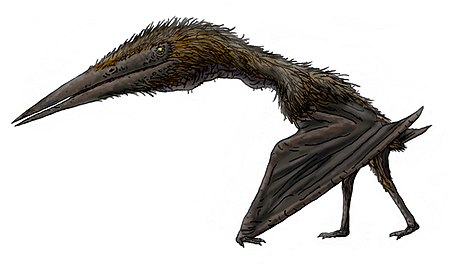
Argentine palaeontologist (born 1987) This biography of a living person needs additional citations for verification. Please help by adding reliable sources. Contentious material about living persons that is unsourced or poorly sourced must be removed immediately from the article and its talk page, especially if potentially libelous.Find sources: Martín Ezcurra – news · newspapers · books · scholar · JSTOR (December 2017) (Learn how and when to remove thi…

Olympic canoeing event Men's K-1 1000 metresat the Games of the XXXII OlympiadCanoeing pictogramVenueSea Forest WaterwayDates2 August 2021 (heats and quarterfinal)3 August 2021 (semifinal & final)Competitors27 from 23 nationsWinning time3:20.643Medalists Bálint Kopasz Hungary Ádám Varga Hungary Fernando Pimenta Portugal← 20162024 → Canoeing at the2020 Summer OlympicsList of canoeistsQualificationSlalomC-1menwomenK-1menwomenSprintC-1 200 mw…

Territory of Imperial Russia from 1898 to 1905 Russian DalianKvantunskaya OblastДальнийКвантунская Область1898–1905 Flag of the Russian EmpireAnthem: Боже, Царя храни!Bozhe Tsarya khrani! (1898–1905)(God Save the Tsar!)Russian DalianStatusLeased territory (colony) of the Russian EmpireCapitalDalniyCommon languagesRussian (official)Mandarin ChineseGovernmentAbsolute monarchyEmperor • 1898–1905 Nicholas II Historical eraNew …
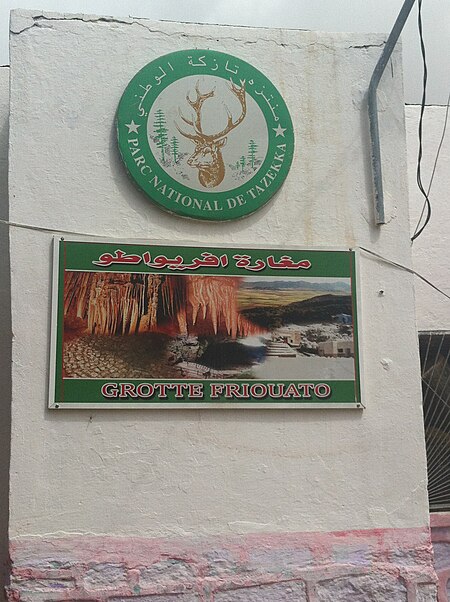
مغارة فريواطومعلومات عامةالمكان تازة البلد المغرب الإحداثيات 34°13′N 4°01′W / 34.22°N 4.02°W / 34.22; -4.02 تعديل - تعديل مصدري - تعديل ويكي بيانات مدخل مغارة فريواطو مغارة فْرِيوَاطُو من بين أهم الأماكن التي يقصدها زوار مدينة تازة الواقعة على بعد 320 كم عن العاصمة المغربية �…
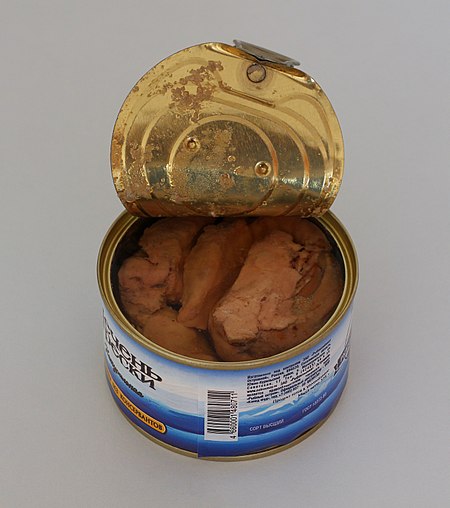
Gadidae fishes in human nutrition and cooking Preserved codfish Cod and other cod-like fish have been widely used as food through history. Other cod-like fish come from the same family (Gadidae) that cod belong to, such as haddock, pollock, and whiting. Cod Canned cod liver Cod is popular as a food with a mild flavour and a dense, flaky white flesh. Young Atlantic cod or haddock prepared in strips for cooking is called scrod. Cod's soft liver can be canned or fermented into cod liver oil, provid…
